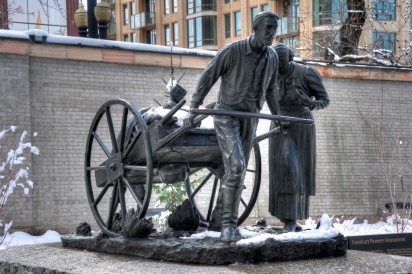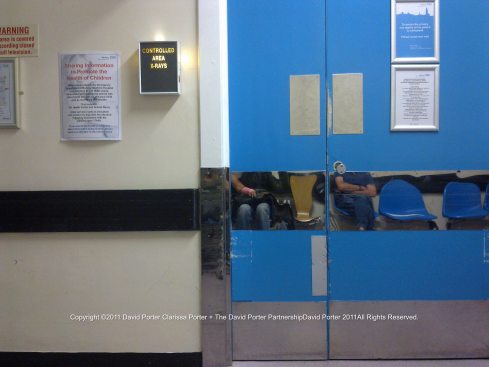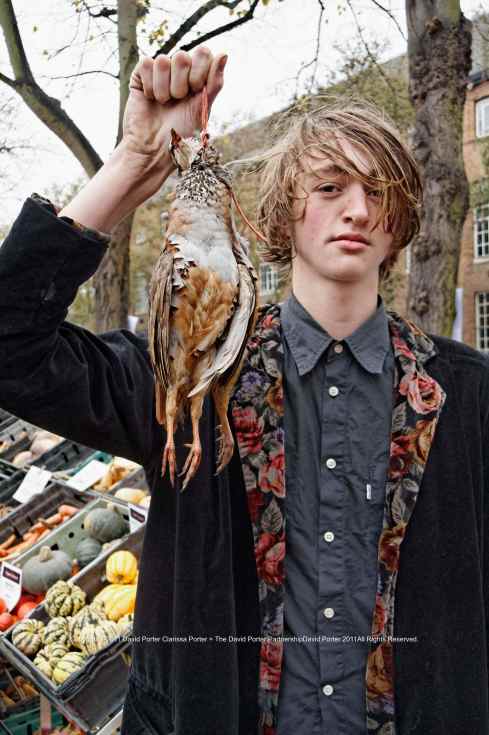The past is another country and in my case it is my scrapbooks, and Rochester and Chatham where I spent three years at art school.
In 1803, in America, the present was another country. Few Americans knew anything about the land west of the Missouri, so President Jefferson sent an expedition of thirty men, led by two young soldiers Lewis and Clark, to explore and map the wilderness.
They didn’t know how long they would be away, or how vast was the country that lay ahead. Dinner was uppermost in their minds and much of their time was spent hunting and foraging for food, which they cooked in a type of pot the early settlers had brought with them from England, the Dutch Oven. Two and half years later Lewis and Clark returned, and wagon trains began spreading westwards towards the Pacific. In the mid 19th Century nearly 3,000 Mormon pioneers, many of them religious refugees from England, pulled handcarts 1,300 miles from Iowa to Utah. No covered wagons for these poor people but hanging proudly from their carts was a Dutch oven.

Mormon Handcart Pioneer Monument in Salt Lake, with Dutch Oven. ©Morris A. Thurston
Americans still celebrate their ancestors reliance on the Dutch oven, holding cook-offs at Dutch Oven Gatherings (DOGs). The DOG season has just started in America, and one favourite dish is the old English ‘pot pie’, also known as a ‘cobbler’. Pot pies are as old as pastry making, and were a regular item on the menus of grand houses in England and France; the ‘four-and-twenty blackbird’ pie was a pot pie. Americans really took pot pies, or cobblers, to their hearts. Regional variations come with colourful names: the Grunt in Massachusetts, the Slump in Vermont, the Buckle, the Betty, and the Sonker! The Brown Betty is a bit like a bread pudding, and the Pandowdy is similar to an apple crumble. The ‘Washington Post’ commented that the phrase “as American as apple pie” should really be “as American as a cobbler”.
Maybe the name came about because they resemble cobblestones, or perhaps because small round loaves were called ‘cobs’ in England. Sometimes uncooked biscuits or suet dumplings were scattered on top of the filling, giving the appearance of a ‘cobbled’ road when the pie was cooked. The ‘Oxford Encyclopedia of Food and Drink in America’ says: “Without brick ovens, colonial cooks often made cobblers in pots over an open fire. As cobblers cook, the filling stews and creates its own sauce and gravy, while the pastry puffs up and dries.” English recipes tend to use a scone type of dough, and in America they use a more crisp pastry.

Dutch Oven ©The Yurt Farm
The Dutch Oven is perhaps the single most important item of cooking equipment in the history of cooking, a simple cauldron with three legs to raise it above the fire and a flat lid with a raised lip allowing coals to be scattered on top; the lid can be used by itself as a skillet. A wire handle attached to the pot allowed the Dutch Oven to be hung over a fire. We still have these pots but now they’ve lost their legs, the lids are rounded, and we call them ‘casseroles’. The hardware shops of Deptford sell ‘Dutch Pots’ or ‘Dutchies’, aluminium pots in varying sizes but no legs, and if you search the internet you’ll find camping shops selling the real thing, a cast iron Dutch oven with legs. In the 17th Century saucepans were mostly made from brass and very expensive. They were handed down through generations, George Washington’s mother stipulated in her will that her ‘kitchen iron-work’ should be divided between her grandchildren. Iron pots were cheaper but heavier, more difficult to make and liable to crack. At school I learned about Abraham Darby and the Industrial Revolution, he was the inventor of the coke-fuelled blast furnace. Darby was manufacturing brass cooking pots in Bristol when in 1704 he travelled to Holland to study a new iron-casting method utilising sand moulds. He brought his skills and some Dutch workers back to England where he carried on experimenting and perfected the iron casting process, making thinner, lighter, and stronger pots.
He moved to bigger works in Coalbrookdale and patented his casting method in 1707 monopolising the cast iron cooking pot market in Britain and America for the next 200 years. There’s something reassuringly sturdy and no-nonsense about cast iron cookware. We have quite a collection of frying pans, griddle pans and pots. I like the gritty blackness of them and the way you never really clean them, they just get better and better. ‘Seasoning’ it’s called, which is now a family joke. Anything I buy or acquire that just sits unused in a corner is described as ‘seasoning’ till the time is right. I’ve a dishwasher seasoning at the moment.
I’ve been taking pictures since I was three, first with my big sister’s box camera which often jammed. Then I’d watch her disappear under the eiderdown to open the camera and free the film. Then she bought a Brownie 127, and I was given a small camera from Woolworths that took 16 pictures on 127 film. It had a plastic tartan case and a wire viewfinder. I’ve still got it somewhere. When I was eleven I started developing my films in my bedroom, see-sawing the rolls through glass rollers in a shallow tank and total darkness before making contact prints. I decided I would be a photographer, my sister Christine encouraged me bringing home the latest cutting-edge magazines with shots by the trendy triumvirate of Duffy, Donovan, and Bailey. ‘Man About Town’. American ‘Esquire’, ‘Queen’, and American ‘Look’ featured inspiring photographs by Irving Penn and William Klein. Sunday supplements appeared featuring photographers such as Don McCullin and Art Kane.
I saved these magazines, cutting out the pictures and sticking them into scrap books. I still have a serious magazine habit, but now I buy most of my glossies from the stall in Deptford Market on Wednesdays, ‘3 for £4’, and my home is stuffed with hundreds, probably thousands of magazines.
My poor mother was dismayed, Christine had been to Wimbledon art school for three years, and her horizons had been broadened. I went to Wimbledon Saturday mornings when I was 10 or 11, but she hoped I’d grow out of it. “Photography is a very expensive hobby,” she said at every opportunity. Followed by a stern, “You needn’t think you’re going to art school.” But I was quietly single-minded, borrowing all the photography books from the library and staring wistfully into the windows of the local camera shop.

Bill Brandt's 1937 picture of a snicket in Halifax, from my Time-Life book 'The Art of Photography', laying on some exposed cobbles in Ashby Road, London SE4.
I tended towards contrasty images of urban black and white emptiness, my favourite picture was Bill Brandt’s shot of a ‘snicket’, a steep ramp of cobbles in Halifax. Christine went to New York for a holiday and came back with “Message From The Interior”, a book of photographs by Walker Evans who became my latest hero.

'Message From The Interior' a collection of photographs © Walker Evans, published by the Eakins Press in New York 1966.
“What was New York like?” I asked her, starry-eyed. “If you don’t look up, it’s just like Tooting,” she said. Luckily my sister’s campaign to get me into art school didn’t waver, and when I was about 16 she bought me a Leica IIIc with a collapsible lens. I left school and took a job so I could buy a second-hand MPP enlarger with all the dishes, paper, and chemicals. When I’d assembled a few prints Christine organised the college applications and then drove me around the country from interview to interview till I found a place in Rochester. Where I met Clarissa, who in the picture below is walking down Constitution Hill in Swansea modelling an Ossie Clark dress for my college-leaving portfolio.
That picture by Bill Brandt of cobbles fascinated me. The streets around my home were once laid with granite setts, and when the surface breaks-up the cobbles reappear. Some streets and mews are still cobbled, Comet Street off Deptford High Street for instance, and Greenwich Market. Lewisham has its own ‘snicket’, White Post Lane. Not so dramatic as the Halifax street but still evocative of a mysterious bygone era.
The streets east of White Post Lane were built in an old quarry, their names give it away: Loampit Hill previously known as Lome Pitt Hole, Sandrock Road, Cliffview, Fossil, Overcliff, and so on. White Post Lane is much older than the houses and used to run along the quarry’s edge from the brick field to Loampit Hill. The cobbled stretch may date from the old quarry workings it seems out of place among the late 19th and early 20th Century houses.
Fours years after art school and at last I was working for magazines photographing rock royalty and some fashion. One day we’d been on a fashion shoot and gave the model a lift home to Chelsea. She invited us in for a coffee, and introduced us to her bemused boyfriend Terry. I was star-struck, more impressed than I’d been meeting Paul McCartney.
Terry de Havilland was the cobbler of the moment, a genius. I had several pairs of platform shoes including a multi-coloured snakeskin pair, a rip-off of Terry’s design. He was very nice and friendly as a proper cockney cobbler should be, and despite his trendy credentials as nice as pie. His shop was on the Kings Road, “Cobblers To The World”, and I’m pleased to say he is still making fantastic shoes.
My recipe is for a Beef Cobbler, real rib-sticking comfort food. You don’t need a Dutch oven to cook a cobbler just the modern equivalent, the casserole dish.
Beef Cobbler
Preparation time : 10 – 15 minutes
Cooking times : 90 minutes (but can be started the day before and cooked in two stages)
Ingredients : (makes 3 or 4 portions)
For the filling,
2 or 3 tbs beef dripping
2 tbs plain flour
Rock salt and freshly ground pepper (to season the flour)
975g beef, I used shin of beef, cut into generous cubes
225g banana shallots, sliced (or 2 small onions, but the shallots are sweeter)
300 ml beef stock
300 ml red wine
4 pickled walnuts, quartered, with 125ml of the vinegar from the jar
2 tbs tomato purée
Bouquet garni of thyme, parsley and bay tied together
For the topping,
450g plain flour
1 tsp English mustard powder
5 tsp baking powder
Salt and pepper
110g butter, cubed
50g walnuts, crushed
2 tbs chopped parsley
300ml milk
1 egg, beaten, to glaze
Some fresh sage leaves
Method :
Melt 2 tbs of the dripping in your casserole dish (mine is 23cm diameter and 10cm deep and it is cast iron). Dust the cubed beef in seasoned flour and brown in batches in the melted dripping before removing with a slotted spoon to a plate.
Add the remaining dripping and soften the shallots., then de-glaze the pan, shallots and all, with the wine, the stock, and a wine glass of the vinegar from the pickled walnuts. Stir-in the tomato purée and return the meat to the dish. Add the pickled walnuts and tuck-in the herbs, take care that the meat is covered by the stock, if not add more beef stock or wine. Cover the casserole with the lid and simmer very gently for three-quarters of an hour.
While this happening, prepare the pastry top. Sift the flour and the baking powder into a large mixing bowl and season with pepper, salt and the mustard powder. Rub in the butter till the mixture resembles bread crumbs and then add the chopped parsley and the chopped walnuts, and stir-in the milk. Knead lightly in the bowl, or tip out and knead, whichever suits you, till everything is combined.
Wrap the dough in clingfilm and chill for at least 30 minutes, or until you are ready. Remove the herbs from the casserole. Take the chilled dough and flatten it with your hands so you have a circle roughly the same size as the casserole lid. You could press the lid gently onto the dough to give you a template for the amount you need to make the cobblers.
Cut across the dough in opposite directions and take each square and using your hands roll it into a ball before flattening it slightly and placing on top of the meat in the casserole. When you’ve finished brush the dough with egg-wash and scatter with some fresh sage leaves.
Cover the casserole with the lid and put into your oven pre-heated to 200C for 10 minutes. Then remove the lid and continue to cook for a further 20 – 30 minutes at 190C.
The cobbler will be golden and crisp on top and underneath steamy, sticky, and soft, the dough having wrapped itself around the beef!
©2012 David Porter



















